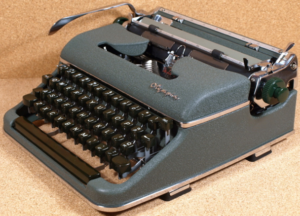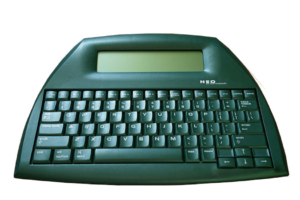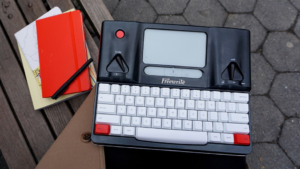While a laptop or standard notebook and pen are the most ubiquitous ways to write in today’s world, many writers are turning to older technology to record their thoughts and ideas. These retro devices bring to mind a 90s high school computer class and aim to replace your laptop and all its distractions when it comes to writing.

Typewriters
At first glance, you might think the use of a typewriter in 2018 is more for aesthetic purposes than productivity. However, this trend has its fair share of supporters. Max Booth, writing for LitReactor, recommends using a typewriter to get your first draft on paper.
“With a typewriter, there’s no moving your cursor back up the page to highlight certain sections or revise,” Booth writes. “What’s written is written. Typewriters force me to continuously move onward until I’ve finished what I have to say.”
And if you’re on a budget, you can get a typewriter that won’t leave you broke. Used typewriters on eBay start at around forty dollars, and you can get a new electronic typewriter (more customizable than a classic typewriter) on Amazon for $140.

Word Processors
For something more modern and less bulky than a typewriter, word processors provide the best of both worlds. The popular word processors of the 1960s were large and had limited memory, but portable word processors more suited for on-the-go use appeared a few decades later.
The Alphasmart Neo, pictured above, and the Neo 2 are the go-to choices for battery-powered word processors. With storage available for up to 200 pages, the Neo and Neo 2 were released in the early 2000s and discontinued in 2013. Since they were still being made when laptops took over the technological world, they come with USB capabilities that allow you to transfer your files to a Windows or Mac computer.

Freewrite
The Freewrite from Astrohaus bills itself as the “world’s first smart typewriter,” and brings a modern touch to the dated word processors and typewriters that have existed for decades. The Freewrite was originally known as the Hemingwrite when it was launched as a Kickstarter project in 2014. Over $300,000 was raised through crowdfunding, and the Hemingwrite evolved into the Freewrite.
The Freewrite can store over a million pages of data and supports dozens of languages. It connects to Wi-Fi to sync your work with Astrohaus’ cloud storage service, Postbox. Once your data is synced with Postbox, you can easily transfer it to other cloud-enabled services like Google Docs or Dropbox.
Despite its impressive specs, the Freewrite debuted to controversy online. Why? The price tag. A base model Freewrite is $499. For a four-pound typewriter with a five-and-a-half-inch screen, that price is a lot to ask. Regardless of this, the Freewrite has its fair share of fans, but perhaps a trial run with a cheaper word processor like the Neo 2 would be smart before shelling out half a grand on this typewriter.
This post is one part of a blog written for Dr. Philip Patterson’s Feature Writing class. This is a series-style blog focusing on innovations in the writing industry, so each post will discuss technology which has helped authors succeed and shape the future of the writing industry, as well as new writing markets, such as e-books and online literary journals.











Be First to Comment